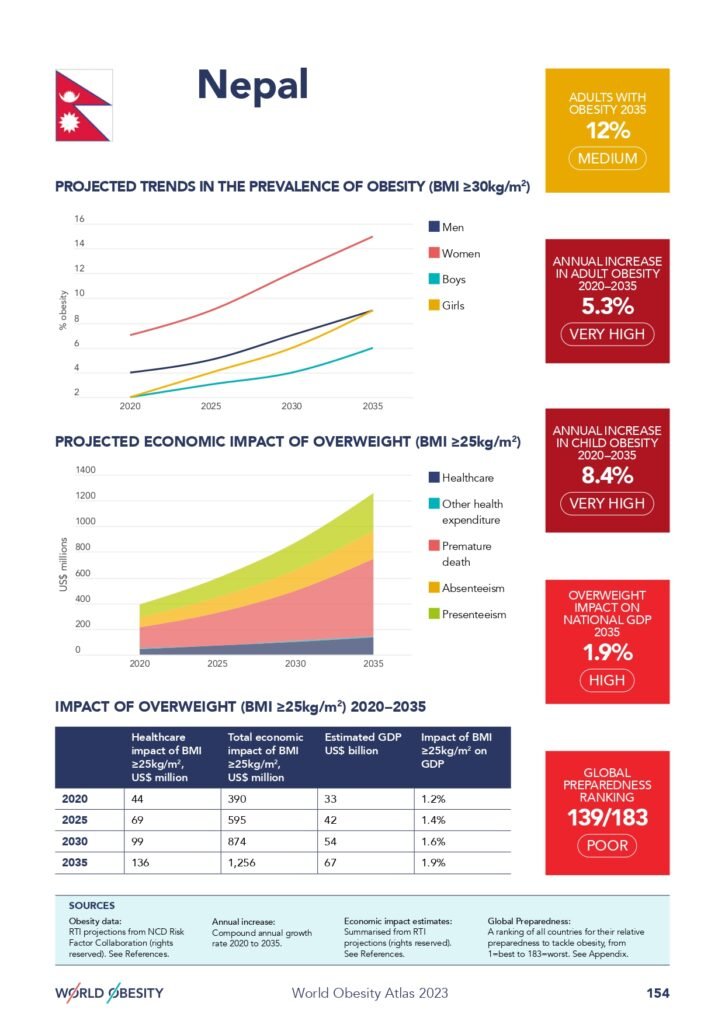World Obesity Atlas 2023 highlights
Global study predicts that more than half the global population will be living with overweight and obesity within 12 years if prevention, treatment and support do not improve.
- The World Obesity Atlas 2023, published by World Obesity Federation, predicts that the global economic impact of overweight and obesity will reach $4.32 trillion annually by 2035 if prevention and treatment measures do not improve. At almost 3% of global GDP, this is comparable with the impact of COVID-19 in 2020.
- The majority of the global population (51%, or over 4 billion people) will be living with either overweight or obesity by 2035 if current trends prevail. 1 in 4 people (nearly 2 billion) will have obesity.
- Childhood obesity could more than double by 2035 (from 2020 levels). Rates are predicted to double among boys to 208 million (100% increase) and more than double among girls to 175 million (125% increase) and are rising more rapidly among children than adults.
- Lower income countries are facing rapid increases in obesity prevalence. Of the 10 countries with the greatest expected increases in obesity globally (for both adults and children), 9 of those are from low or lower-middle income countries. All are from either Asia or Africa.
- World Obesity Federation calls for comprehensive national action plans to help countries act on new World Health Organization (WHO) Recommendations for the Prevention and Management of Obesity. The Atlas report will be presented at a high-level policy event on 6 March to UN policymakers, member states and civil society.
- Acknowledgement of the economic impact is in no way a reflection of blame on people living with obesity, which is a chronic, relapsing disease.
A new World Obesity Atlas report from the World Obesity Federation, published on World Obesity Day, predicts that 51% of the global population will be living with overweight or obesity by 2035 based on current trends. Continued failure to improve prevention and treatment could contribute to a total economic impact of US$4.32 trillion by 2035-nearly 3% of global GDP. These new figures represent a significant increase on current levels and lend urgency to World Obesity Federation’s calls for the development of national obesity action plans around the world.
Urgent call for national action plans at high-level policy event
The launch of the Atlas report will be marked with a high-level policy event: ‘Changing perspectives and advancing national action’ on Monday 6 March 2023, 13:00 CET (12:00 GMT). During the event, World Obesity Federation and partners will lead calls for a robust international response. The Atlas report discusses the importance of national action plans and Universal Health Coverage to help countries implement new WHO Recommendations for the Prevention and Management of Obesity that were adopted in 2022.

Recommended reading
- Nepal Health Facility Survey 2021 Preliminary Data Tables
- Preliminary Findings: Nepal Health Facility Survey 2021
- Second Round Seroprevalence Survey for SARS-COV-2
- The 2nd National Sero-prevalence Survey of Nepal for COVID-19
- Waste Management Baseline Survey of Nepal 2020
- National Mental Health Survey, Nepal-2020 Fact Sheet
- Nepal Multiple Indicator Cluster Survey 2019 (NMICS 2019): Key findings
- National TB Prevalence Survey, 2018-19 Key findings
- Nepal STEPS Survey 2019- Province wise Fact Sheets
- NEPAL–NCDs risk factors STEPS Survey 2019 – Tobacco Factsheet
- Nepal STEPS Survey 2019 Alcohol Consumption and Policy Fact Sheet
- National NCD Risk Factor Survey (WHO-STEP Survey) 2019,Nepal
- Nepal National Micronutrient Status Survey 2016
- The 2015 Nepal Health Facility Survey: Further Analysis Reports
- Key Indicators: The Nepal Demographic and Health Survey (1996 NDHS- 2016 NDHS)
- Key Findings (Nepali & English) – The 2016 Nepal Demographic and Health Survey (2016 NDHS)
- Nepal Demographic and Health Survey 2016 Key Indicators Report
- Nepal Demographic and Health Survey 2016 Key Indicators Report (Short Notes)
- The 2016 Nepal Demographic and Health Survey (2016 NDHS)
- Key findings – The 2015 Nepal Health Facility Survey (2015 NHFS)
- Nepal Health Facility Survey (2015 NHFS) Preliminary Report
- Nepal Multiple Indicator Cluster Survey (MICS 2014) Final Report


